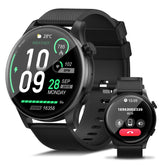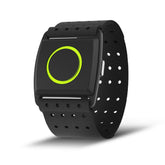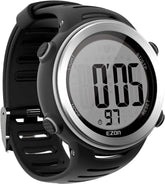Beginner’s Guide to 10K Running: Step Count Watches & Progress Tracking
Embarking on your 10K running journey? This 12-week 10k training plan beginner combines step count watches for progress tracking, interval training for stamina building, and expert tips to master running form and injury prevention. Let’s turn your couch-to-10K dream into reality!
1. Pre-Training Prep: Gear Up and Set Goals
A. Choose the Right Step Count Watch
-
Key Features:
- Step Accuracy: Look for watches with accelerometer + GPS (e.g., EZON Step Tracker Watch) to log every stride.
- Heart Rate Zones: Monitor effort levels to avoid overexertion (Zone 2 = 60–70% MHR for fat burn).
- Daily Activity Tracking: Set a baseline goal (e.g., 5,000 steps/day) and gradually increase by 10% weekly.
B. Set SMART Goals
- Specific: “Run 10K without stopping in 12 weeks.”
- Measurable: Use your watch to track weekly mileage (e.g., Week 1: 10K total; Week 12: 30K total).
- Attainable: Follow the 12-week plan below, designed for beginners with no prior running experience.
2. The 12-Week Training Plan: From Walk-Run to 10K
Phase 1: Base Building (Weeks 1–4)
Goal: Build consistency and adapt to movement.
-
Workout Structure:
-
3x/week walk-run intervals:
- Week 1: 1 min run + 2 min walk × 10 (total 30 mins).
- Week 4: 3 min run + 1 min walk × 8 (total 32 mins).
- Daily Steps: Aim for 7,000–8,000 steps (use step count watch alerts to stay on track).
-
3x/week walk-run intervals:
Phase 2: Strength & Stamina (Weeks 5–8)
Goal: Increase running time and introduce hills.
-
Workout Structure:
-
3x/week runs:
- Week 5: 5 min run + 1 min walk × 5 (25 mins running).
- Week 8: 8 min run + 1 min walk × 4 (32 mins running).
- Hill Training: Add 1x/week 5-min uphill walks to build leg strength (use watch GPS to find routes with 5–10% incline).
-
3x/week runs:
Phase 3: Race Prep (Weeks 9–12)
Goal: Simulate race conditions and refine pace.
-
Workout Structure:
-
Long Runs:
- Week 9: 6K continuous run (first “non-stop” milestone).
- Week 12: 10K practice run at race pace (use watch pace alerts: e.g., 6–7 min/km for beginners).
- Taper Week (Week 12): Reduce mileage by 50% to rest muscles.
-
Long Runs:
3. Master Running Form to Avoid Injury
A. The 4 Keys to Proper Form
- Foot Strike: Land midfoot to reduce knee impact (avoid heel striking).
- Posture: Keep your back straight and shoulders relaxed—use watch vibration alerts to correct slouching.
- Arm Swing: Bend elbows at 90°, swing forward/back (not across the body).
- Pace Control: Use interval training to maintain steady effort (e.g., Zone 3, 70–80% MHR).
B. Injury Prevention Tips
-
Warm-Up/Cool-Down:
- 5–10 mins dynamic stretching (leg swings, lunges) pre-run; static stretches (hamstring, calf) post-run.
-
Strength Training:
- 2x/week workouts: Squats, lunges, planks to strengthen hips and core.
- Rest Days: Take 1–2 days off weekly to let joints recover (watch HRV data can signal readiness for activity).
4. Leverage Your Step Count Watch for Progress
A. Daily Tracking Essentials
- Step Goals: Gradually increase from 7,000 to 10,000 steps/day by Week 12.
- Active Minutes: Aim for 60+ mins/day of light activity (walking, stretching) to boost metabolism.
- Sleep Monitoring: Ensure 7–9 hours of sleep for muscle repair (use watch sleep staging to optimize bedtime).
B. Race-Day Strategy
- Pace Planning: Set a target finish time (e.g., 60–70 mins) and divide into splits (e.g., 5K at 30–35 mins).
- Fueling Alerts: Program watch reminders for water/gels every 30 mins during long runs.
5. Nutrition and Recovery for Beginners
A. Pre/Post-Run Fuel
-
Pre-Run (1 hour before):
- 50–100g carbs (e.g., banana + toast) for energy.
-
Post-Run (30 mins after):
- 20g protein + 50g carbs (e.g., chicken salad + quinoa) to repair muscles.
B. Hydration and Electrolytes
- During Runs >60 mins: Sip water + electrolytes (500mg sodium/L) to avoid cramps.
- Watch Insight: Use sweat rate data (calculated via GPS + heart rate) to adjust fluid intake.
6. Common Mistakes to Avoid
-
Overtraining:
- Solution: Follow the plan strictly; don’t skip rest days (use watch fatigue alerts).
-
Ignoring Pain:
- Solution: If joint pain persists >2 days, swap running for cycling/swimming.
-
Inconsistent Tracking:
- Solution: Wear your step count watch daily to stay accountable.
7. FAQs: Your 10K Questions Answered
Q: How to stay motivated on tough days?
- Track non-scale wins: “Today’s run felt easier than last week!” or “Hit a new step record.”
Q: What if I can’t complete a workout?
- No pressure! Repeat the previous week’s routine until you feel ready to progress.
Q: Best shoes for beginners?
- Choose neutral running shoes with adequate cushioning (e.g., Brooks Ghost, Nike Pegasus).
Cross the Finish Line with Confidence
With a 10k training plan beginner and step count watch as your allies, every step brings you closer to your 10K goal. Focus on gradual progress, prioritize form and recovery, and celebrate each milestone—whether it’s hitting 10,000 steps or completing your first non-stop 5K.
Remember, the journey matters as much as the finish line. Lace up, hit start on your watch, and let every stride be a step toward strength, resilience, and the thrill of crossing that 10K finish line. You’ve got this!
EZON Watch: Your Partner in Every Step
Shop Step Count Watches
Shop Step Count Watches









